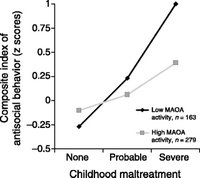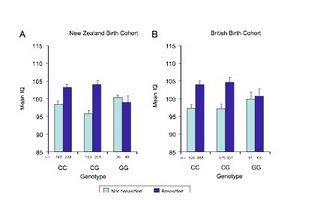|
Saturday, November 17, 2007
Razib noted, in his post on the IQ-breastfeeding-FADS2 story, that it reminded him of research on MAOA. There's a reason: it's by the same group. In fact, the IQ study is the third in a "trifecta" of gene-environment interactions postulated by Avshalom Caspi and colleagues. Curious about whether their statistical methods were similar in all these studies, I went back to them.
 1. In 2002, the authors reported an interaction between variation in MAOA and childhood maltreatment on the probability of developing "antisocial problems". The relevant graph is on the right. It's important to keep in mind, from a statistical standpoint, what an interaction is: in a regression of variable Y on variable X, if the slope of the line significantly differs depending on another variable Z, one concludes for an interaction between Z and X. In this, the slopes do appear to be different, and the authors find this is indeed statistically supported. They don't include parental "antisocial behavior" as a covariate in their regression, either because they don't have that data or didn't think to include it. 1. In 2002, the authors reported an interaction between variation in MAOA and childhood maltreatment on the probability of developing "antisocial problems". The relevant graph is on the right. It's important to keep in mind, from a statistical standpoint, what an interaction is: in a regression of variable Y on variable X, if the slope of the line significantly differs depending on another variable Z, one concludes for an interaction between Z and X. In this, the slopes do appear to be different, and the authors find this is indeed statistically supported. They don't include parental "antisocial behavior" as a covariate in their regression, either because they don't have that data or didn't think to include it.  2. In 2003, the authors then genotyped another locus in the cohort studied above, this time the serotonin transporter. They reported a significant interaction between polymorphism in this gene and stressful life events on risk of depression. Again the relevant graphs are on the right. Across several measures of depression, there does appear to be an interaction. Again, no inclusion of parental phenotype in the regression. 2. In 2003, the authors then genotyped another locus in the cohort studied above, this time the serotonin transporter. They reported a significant interaction between polymorphism in this gene and stressful life events on risk of depression. Again the relevant graphs are on the right. Across several measures of depression, there does appear to be an interaction. Again, no inclusion of parental phenotype in the regression.  3. Now let's consider the IQ-FADS2 story. Again, they use the same cohort (as well as a replication cohort). This time, instead of genotyping known functional variants in a gene thought to be involved in the phenotype, they genotype a couple tagging SNPs in a gene picked through some spectacular logical leaps (1. there is a link between breastfeeding and IQ. 2. That link is modulted through fatty acid metabolism. 3. Of all the genes involved in fatty acid metabolism, the one of interest is FADS2). This has to change your priors on whether anything they find is real. Again, check the graph on the right: this time, they don't have the nice dose-response curve that they had in the others, so they go for a bar chart. And it does indeed look a little noiser. The replication, though, is something that wasn't present in the other studies. 3. Now let's consider the IQ-FADS2 story. Again, they use the same cohort (as well as a replication cohort). This time, instead of genotyping known functional variants in a gene thought to be involved in the phenotype, they genotype a couple tagging SNPs in a gene picked through some spectacular logical leaps (1. there is a link between breastfeeding and IQ. 2. That link is modulted through fatty acid metabolism. 3. Of all the genes involved in fatty acid metabolism, the one of interest is FADS2). This has to change your priors on whether anything they find is real. Again, check the graph on the right: this time, they don't have the nice dose-response curve that they had in the others, so they go for a bar chart. And it does indeed look a little noiser. The replication, though, is something that wasn't present in the other studies. The fact that they have a measure of maternal IQ but don't directly include it in the published multiple regression suggests that they tried it, but didn't like the results. They didn't include parental phenotype in any of their previous studies, but there, at least, there was some functional evidence linking the polymorphism and the phenotype. Here, there's nothing. Considering the fact mentioned in a previous post that other researchers find absolutely no evidence for link between IQ and breastfeeding (the entire basis for this study), this has to be classified as highly questionable. And regardless of the veracity of any gene-environment interactions here, the huge effects of breastfeeding on IQ shown by the authors are clearly artefacts of the heritability of IQ, and it's unfortunate that they are being propogated. Half Sigma is apoplectic about this; I'm not so much-- this is a case of researchers having a hammer (their cohort and a desire to find gene-environment interactions), and seeing every problem as a nail, not some ode to breast-feeding. Anyways, on a completely unrelated note, here's small nugget from their Supplementary Table 2, where they break down IQ by social class. I suppose I'd seen figures like this before (ie. in The Bell Curve), but it still gave me a start: Low class: 93.5 (11.6) Middle class: 100.5 (13.7) High class: 111.4 (12.8) In parentheses are standard deviations. |



